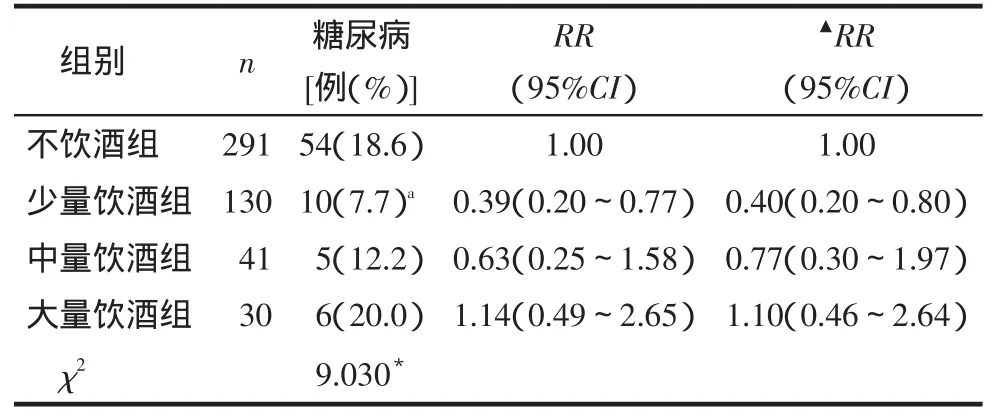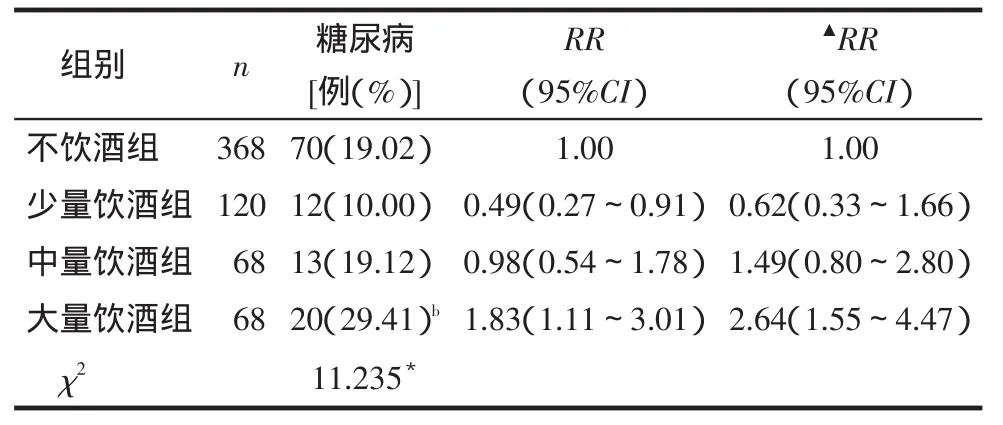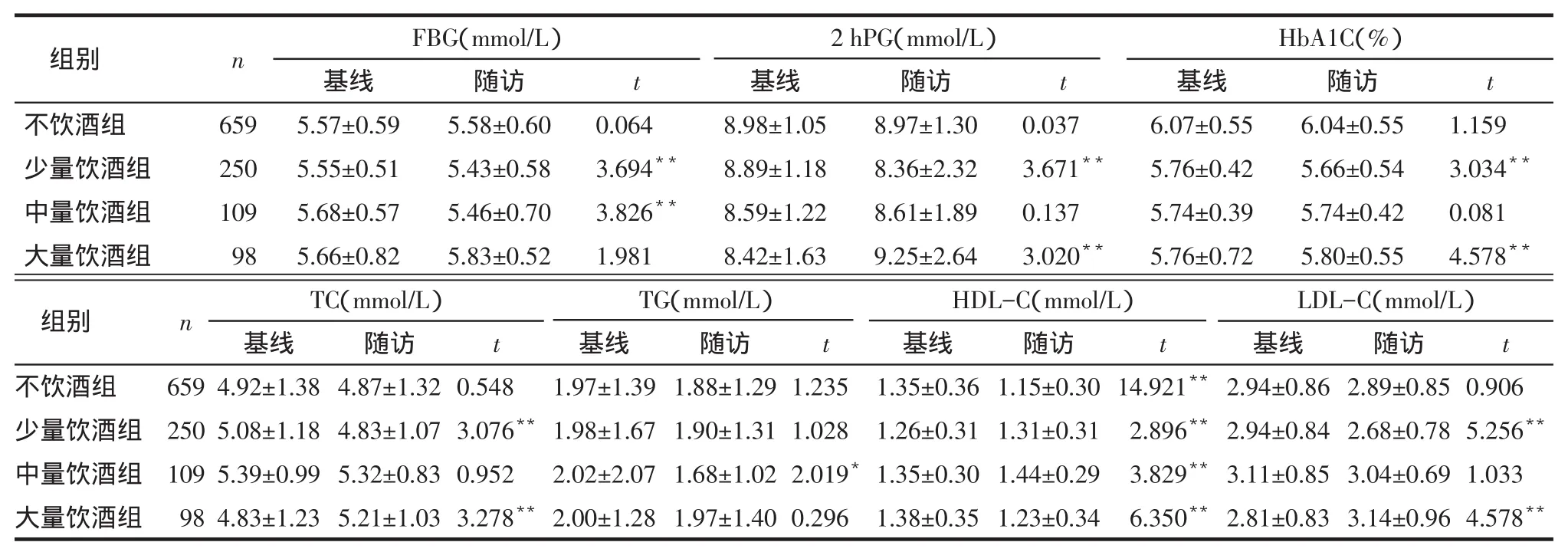饮酒量与糖尿病前期3年转归关系的前瞻性研究
2015-11-24车晓礼万沁
车晓礼,万沁
饮酒量与糖尿病前期3年转归关系的前瞻性研究
车晓礼1,2,万沁1△
目的探讨饮酒量与糖尿病前期3年转归的关系。方法研究对象来自泸州地区2型糖尿病患者肿瘤发生风险的流行病学研究,从基线调查中筛选出糖尿病前期人群1 125例。按饮酒量分为不饮、少量、中量和大量饮酒4组,按体质指数(BMI)是否大于24 kg/m2分2组。对所调查对象进行3年随访。比较不同饮酒量和BMI水平糖尿病发生情况。结果完成随访1 116例,失访9例。不饮、少量、中量和大量饮酒组糖尿病发病率分别为18.81%、8.80%、16.51%、26.53%。Cox比例风险回归分析显示,调整性别、年龄、BMI、热量、基线血糖因素后,少、中、大量饮酒组与不饮酒组糖尿病发病相对风险比RR及95%CI分别为0.49(0.31~0.79)、1.15(0.69~1.92)、1.95(1.25~3.04)。按BMI分组比较:BMI<24 kg/m2人群少、中、大量饮酒组与不饮酒组糖尿病发病风险比RR及95%CI分别为:0.40(0.20~0.80)、0.77(0.30~1.97)、1.10(0.46~2.64);BMI≥24 kg/m2人群少、中、大量饮酒组与不饮酒组糖尿病发病风险比RR及95%CI分别为:0.62(0.33~1.66)、1.49(0.80~2.80)、2.64(1.55~4.47)。结论少量饮酒可以降低BMI<24 kg/m2糖尿病前期人群的糖尿病发病风险,对于BMI≥24 kg/m2人群大量饮酒则增加糖尿病发病风险。
饮酒;糖尿病前期;发病率;前瞻性研究;随访研究
我国糖尿病前期患病率日益增加,糖尿病前期作为糖尿病强大的后备军,每5年约8.4%的糖调节受损(IGR)发展为糖尿病;相比单纯空腹血糖调节受损(IFG)或糖耐量减低(IGT)者,IFG合并IGT发展为糖尿病的风险每5年约为11.4%[1]。在糖尿病前期进行正确的干预可延缓或阻止其向糖尿病发展。生活方式干预是最基本也是最简单的方式,正确的生活干预不仅可以帮助控制血糖,在预防高血压、血脂异常及心血管疾病方面也有重要的作用。饮酒作为人们生活习惯的一部分,研究饮酒与糖尿病前期转归的关系显得尤为重要。目前已有小样本的流行病学研究提出少量饮酒能减少糖尿病前期人群糖尿病的发生,但国内尚缺少大样本的前瞻性研究。为此,本研究通过对不同饮酒量的糖尿病前期人群进行3年随访,旨在探讨酒精(乙醇)摄入量与糖尿病前期转归的关系,为糖尿病前期人群正确的饮酒习惯提供临床参考。
1 对象与方法
1.1 研究对象本研究调查对象来自2011年5月—8月泸州地区2型糖尿病患者肿瘤发生风险的流行病学调查的部分数据,采用多级抽样方法,先采用整群抽样方法抽取泸州市茜草、大山坪和龙马潭3个社区,每个社区内再采用简单随机抽样方法抽取到个人,再从基线调查中筛查出其中糖尿病前期并自愿接受随访调查的对象1 125例。所有对象均签署知情同意书,并自愿参与随访。按饮酒量不同分为不饮酒、少量饮酒、中量饮酒和大量饮酒4组进入研究。
1.2 研究方法基线调查内容:(1)问卷。对调查对象进行标准化问卷,包括姓名、性别、年龄、饮酒量、饮酒种类、饮酒频率、糖尿病家族史等。参与问卷者通过统一培训。(2)体格检查。包括身高、体质量、腰围、血压等。(3)生化检测。空腹血糖(FBG)、餐后2 h血糖(2 hPG;无糖尿病病史者予75 g无水葡萄糖,有糖尿病者予100 g无糖馒头)、糖化血红蛋白(HbA1C)、血脂等。(4)饮酒量的计算。根据调查对象自诉饮酒习惯,过去12个月中每月饮酒不超过1次者定为不饮酒,每周饮酒少于1次者定义为偶尔饮酒,每日饮酒量按每月总量除以30。每周饮酒者定义为经常饮酒者,计算每周饮酒总量,然后除以7,得到每日饮酒量。不同种类的酒含乙醇量根据中国2004年食物成分表计算,高度酒每50 mL含乙醇21.85 g,低度酒每50 mL含乙醇15.75 g,一瓶640 mL的啤酒含乙醇31.36 g,红酒含乙醇5.2 g。(5)于2014年5月—7月对所有对象进行随访,重点随访糖尿病发生情况及血糖、血压等指标变化。
1.3 参考标准(1)糖尿病和糖尿病前期诊断参照WHO 1999年推荐的诊断标准。(2)体质量指数(BMI)分组参照《中国成人超重和肥胖预防指南》,分为BMI<24 kg/m2和BMI≥24 kg/m2组。(3)饮酒分组:根据中国非酒精性脂肪性肝病诊疗指南(2010年修订版),按照饮酒剂量不同分为不饮酒组(0 g/d)、少量饮酒组(0.1~19.9 g/d)、中量饮酒组(20.0~39.9 g/d)和大量饮酒组(≥40 g/d)[2]。
1.4 统计学方法调查数据采用SPSS 17.0进行统计分析。正态分布计量资料以均数±标准差()表示,多组比较采用方差分析,两样本均数前后比较用配对t检验,组间率的比较采用χ2检验,发病风险采用Cox比例风险回归分析。P<0.05为差异有统计学意义。
2 结果
2.1 不同饮酒量队列人群的基线特征完成随访人群共1 116例,因电话改变未联系到本人致失访9例,其中不饮酒组4例、少量饮酒组3例、中量饮酒1例、大量饮酒组1例。随访对象基线特征见表1。

Tab.1Comparison of baseline characteristics between different drinking groups表1 不同饮酒量队列人群的基线特征
2.2 不同饮酒量组糖尿病发病情况少量饮酒组糖尿病发病率最低,大量饮酒组发病率显著高于少量饮酒组。Cox回归分析显示,少量饮酒组糖尿病发病风险低于不饮酒组,而大量饮酒组糖尿病发病风险高于不饮酒组,调整性别、年龄、BMI、热量摄入、基线血糖混杂因素后,结果不变,见表2。

Tab.2Cox proportional hazards regression analysis for patients with DM in different drinking groups表2 不同饮酒组糖尿病发病关系的Cox比例风险回归分析
2.3 不同BMI糖尿病前期人群糖尿病发病情况BMI<24 kg/m2人群中少量饮酒组糖尿病发病率最低。Cox回归分析显示,少量饮酒组相比不饮酒组糖尿病发病风险低;调整性别、年龄、BMI、热量摄入、基线血糖因素后,少量饮酒组糖尿病发病风险仍低于不饮酒组,见表3。BMI≥24 kg/m2人群中大量饮酒组糖尿病发病率高于少量饮酒组。Cox回归分析显示,少量饮酒组相比不饮酒组糖尿病发病风险低,而大量饮酒组相比不饮酒组糖尿病发病风险高;调整混杂因素后,少量饮酒组相比不饮酒组降低糖尿病发病风险差异无统计学意义,而大量饮酒组糖尿病发病风险仍高于不饮酒组,见表4。

Tab.3Cox proportional hazards regression analysis for DM patients with BMI<24 kg/m2in different drinking groups表3 BMI<24 kg/m2人群不同饮酒组糖尿病发病关系的Cox比例风险回归分析

Tab.4Cox proportional hazards regression analysis for DM patients with BMI≥24 kg/m2in different drinking groups表4BMI≥24 kg/m2人群不同饮酒组糖尿病发病关系的Cox比例回归分析
Tab.5Comparison of clinical indicators between different groups表5 各组随访与基线临床指标比较

Tab.5Comparison of clinical indicators between different groups表5 各组随访与基线临床指标比较
组别不饮酒组少量饮酒组中量饮酒组大量饮酒组n H b A 1 C(%)F B G(m m o l / L)基线5 . 5 7 ± 0 . 5 9 5 . 5 5 ± 0 . 5 1 5 . 6 8 ± 0 . 5 7 5 . 6 6 ± 0 . 8 2随访8 . 9 7 ± 1 . 3 0 8 . 3 6 ± 2 . 3 2 8 . 6 1 ± 1 . 8 9 9 . 2 5 ± 2 . 6 4随访5 . 5 8 ± 0 . 6 0 5 . 4 3 ± 0 . 5 8 5 . 4 6 ± 0 . 7 0 5 . 8 3 ± 0 . 5 2 t 2 h P G(m m o l / L)基线8 . 9 8 ± 1 . 0 5 8 . 8 9 ± 1 . 1 8 8 . 5 9 ± 1 . 2 2 8 . 4 2 ± 1 . 6 3 t t 6 5 9 2 5 0 1 0 9 9 8 0 . 0 6 4 3 . 6 9 4**3 . 8 2 6**1 . 9 8 1 0 . 0 3 7 3 . 6 7 1**0 . 1 3 7 3 . 0 2 0**基线6 . 0 7 ± 0 . 5 5 5 . 7 6 ± 0 . 4 2 5 . 7 4 ± 0 . 3 9 5 . 7 6 ± 0 . 7 2随访6 . 0 4 ± 0 . 5 5 5 . 6 6 ± 0 . 5 4 5 . 7 4 ± 0 . 4 2 5 . 8 0 ± 0 . 5 5 1 . 1 5 9 3 . 0 3 4**0 . 0 8 1 4 . 5 7 8**组别不饮酒组少量饮酒组中量饮酒组大量饮酒组n T C(m m o l / L)基线4 . 9 2 ± 1 . 3 8 5 . 0 8 ± 1 . 1 8 5 . 3 9 ± 0 . 9 9 4 . 8 3 ± 1 . 2 3随访4 . 8 7 ± 1 . 3 2 4 . 8 3 ± 1 . 0 7 5 . 3 2 ± 0 . 8 3 5 . 2 1 ± 1 . 0 3 t T G(m m o l / L)基线1 . 9 7 ± 1 . 3 9 1 . 9 8 ± 1 . 6 7 2 . 0 2 ± 2 . 0 7 2 . 0 0 ± 1 . 2 8随访1 . 8 8 ± 1 . 2 9 1 . 9 0 ± 1 . 3 1 1 . 6 8 ± 1 . 0 2 1 . 9 7 ± 1 . 4 0 t t t 6 5 9 2 5 0 1 0 9 9 8 0 . 5 4 8 3 . 0 7 6**0 . 9 5 2 3 . 2 7 8**1 . 2 3 5 1 . 0 2 8 2 . 0 1 9*0 . 2 9 6 H D L -C(m m o l / L)基线1 . 3 5 ± 0 . 3 6 1 . 2 6 ± 0 . 3 1 1 . 3 5 ± 0 . 3 0 1 . 3 8 ± 0 . 3 5随访1 . 1 5 ± 0 . 3 0 1 . 3 1 ± 0 . 3 1 1 . 4 4 ± 0 . 2 9 1 . 2 3 ± 0 . 3 4 1 4 . 9 2 1**2 . 8 9 6**3 . 8 2 9**6 . 3 5 0**L D L -C(m m o l / L)基线2 . 9 4 ± 0 . 8 6 2 . 9 4 ± 0 . 8 4 3 . 1 1 ± 0 . 8 5 2 . 8 1 ± 0 . 8 3随访2 . 8 9 ± 0 . 8 5 2 . 6 8 ± 0 . 7 8 3 . 0 4 ± 0 . 6 9 3 . 1 4 ± 0 . 9 6 0 . 9 0 6 5 . 2 5 6**1 . 0 3 3 4 . 5 7 8**
2.4 不同饮酒组随访与基线各指标比较不饮酒组FBG、2 hPG及HbA1C随访与基线比较差异无统计学意义;少量饮酒组FBG、2 hPG及HbA1C随访较基线均下降;中量饮酒组FBG随访较基线下降,2 hPG和HbA1C随访与基线比较差异无统计学意义。胆固醇(TC)随访较基线在少量饮酒组显著下降,大量饮酒组显著升高(P<0.01)。三酰甘油(TG)中量饮酒组随访较基线显著下降,其余各饮酒组随访与基线比较差异无统计学意义。高密度脂蛋白胆固醇(HDL-C)在不饮酒组和大量饮酒组随访较基线显著下降,少量饮酒和中量饮酒组随访较基线显著升高(P<0.01)。低密度脂蛋白胆固醇(LDL-C)少量饮酒组随访较基线显著下降,大量饮酒组随访较基线显著升高(P<0.01),见表5。
3 讨论
3.1 饮酒与糖尿病前期转归的关系既往国内外研究提出少量饮酒能降低糖尿病发病风险[3-5]。周建扬等[3]对98例糖尿病前期患者调查发现,大量饮酒组28例中19例发展为糖尿病,无一例好转为正常糖耐量者;而少量饮酒组的30例患者中4例发展为糖尿病,8例转为正常糖耐量者;未饮酒组的40例有6例发展成糖尿病,7例转为正常糖耐量者。Crandall等[4]对3 175例糖尿病高危人群进行研究,经过3.2年的随访发现,轻度饮酒组(10~30 g/d)糖尿病发病率比不饮酒组、过度饮酒组(>30 g/d)和酗酒组(>70 g/d)低。Cullmann等[5]对糖尿病前期的70例男性和41例女性进行8~10年随访发现,男性酗酒增加糖尿病前期患糖尿病的风险[OR及95%CI为1.67(1.11,2.50)],而女性适量饮酒能降低糖尿病发病风险[OR及95%CI为0.41(0.22,0.79)]。本研究结果显示,少量饮酒组糖尿病发病率最低,大量饮酒
组糖尿病发病率最高,且少量饮酒组糖尿病发病风险低于不饮酒组,大量饮酒组糖尿病发病风险高于不饮酒组。
3.2 饮酒与糖尿病前期不同BMI人群转归的关系由于糖尿病前期糖耐量受损情况不同,糖尿病前期转归也不同。本研究发现BMI<24 kg/m2人群少量饮酒可降低糖尿病发病风险,BMI≥24 kg/m2组少量饮酒不能降低糖尿病发病风险,相反,大量饮酒增加发病风险。Wakabayashi[6]研究饮酒对肥胖人群糖尿病发病风险的影响,该研究纳入12 627例肥胖患者,调查发现与不饮酒组相比,每日饮酒量<40 g有助于降低糖尿病发病风险[OR及95%CI为0.61(0.41,0.91)]。Metcalf等[7]研究纳入5 512例40岁以上的非糖尿病人群,分为正常、超重、肥胖组,分析各组饮酒与糖尿病发病率的关系,结果显示少量(<5 g/d)的乙醇摄入仅能降低非肥胖人群糖尿病发病率,不能降低肥胖人群糖尿病发病率,正常、超重、肥胖组少量饮酒发病风险RR及95%CI分别为0.04(0.01,0.38)、0.30(0.10,0.86)、0.99(0.55,1.79),而中量饮酒(5~20 g/d)仅能降低非超重人群糖尿病发病率,正常、超重、肥胖组中量饮酒发病风险RR及95%CI分别为0.23(0.06,0.83)、0.60(0.23,1.60)、0.93(0.48,1.82)。虽然目前的研究结果尚存在一定差异,但对超重、肥胖的糖尿病前期患者积极控制体质量和饮酒量对健康无疑是有益的。另有研究指出在超重男性中饮酒剂量与胰岛素抵抗显著相关,而在非超重男性中,饮酒时间的长短与胰岛素之间的相关性更强[8]。但上述研究均未考虑饮酒时间的影响,因此,饮酒、肥胖及糖尿病三者的关系仍需要进一步证实。
3.3 饮酒与糖尿病关系机制的探讨饮酒影响糖尿病的机制成为人们关注的焦点,目前推测其可能与适量饮酒增加HDL-C水平,大量饮酒降低HDLC水平有关。Beulens等[9]研究发现适量饮酒对糖尿病的保护作用主要归因于增加HDL-C水平。本研究结果显示少量饮酒组FBG、2 hPG及HbA1C水平较基线显著下降的同时HDL-C水平显著升高;大量饮酒组FBG、2 hPG及HbA1C水平较基线显著升高,HDL-C显著降低。
目前,糖尿病前期尚未引起人们重视,但越来越多的研究均证实了糖尿病前期生活方式的重要性。本研究针对饮酒对糖尿病前期的影响结果显示,少量的饮酒可以降低糖尿病前期糖尿病发病率,饮酒过量则会增加糖尿病发病率,因此建议糖尿病前期患者饮酒应有度,尤其是超重和肥胖人群更应严格限制饮酒量。该研究随访时间为3年,对于饮酒的长期影响需要更长时间的随访研究证实。
[1]Feng B,Qian QH,Li X,et al.Five-year outcome of impaired glucose regulation and its risk factors in community residents[J].Chinese Journal of Diabetes Mellitus,2010,2(2):101-105.[冯波,钱巧慧,李栩,等.社区自然人群糖调节受损者5年转归及其影响因素[J].中国糖尿病杂志,2010,2(2):101-105].doi:10.3760/cma.j. issn.1674-5809.2010.02.006.
[2]The Chinese National Workshop on Fatty Liver and Alcoholic Liver disease for the Chinese Liver Disease Association.Guidelines for management of nonalcoholic fatty liver disease:an updated and revised edition[J].Chinese Journal of Gastroenterology and Hepatology,2010,19(6):483-487.[中华医学会肝病学会脂肪肝和酒精性肝病学组.非酒精性脂肪性肝病诊疗指南(2010年修订版)[J].胃肠病和肝病学杂志,2010,19(6):483-487].doi:10.3969/j.issn.1006-5709.2010.06.001.
[3]Zhou JY,Zhao WJ.The influence of drinking and blood glucose on the people of impaired glucose regulation[J].Journal of Practical Diabetology,2009,5(1):41-42.[周建扬,赵文娟.饮酒对不同糖调节受损人群血糖的影响[J].实用糖尿病杂志,2009,5(1):41-42].
[4]Crandall JP,Polsky S,Howard AA,et al.Alcohol consumption and diabetes risk in the Diabetes Prevention Program[J].Am J Clin Nutr,2009,90(3):595-601.doi:10.3945/ajcn.2008.27382.
[5]Cullmann M,Hilding A,Ostenson CG,et al.Alcohol consumption and risk of pre-diabetes and type 2 diabetes development in a Swedish population[J].Diabete Med,2012,29(4):441-452.doi: 10.1111/j.1464-5491.2011.03450.
[6]Wakabayashi I.Light-to-moderate alcohol drinking reduces the impact of obesity on the risk of diabetes mellitus[J].J Stud Alcohol Drugs,2014,75(6):1032-1038.
[7]Metcalf PA,Scragg RK,Jackson R.Light to moderate alcohol consumption is protective for type 2 diabetes mellitus in normal weight and overweight individuals but not the obese[J].J Obes,2014,2014:634587.doi:10.1155/2014/634587.
[8]Yue F,Zhang X,Zhang H,et al.Association of alcohol consumption with the impaired β-cell function independent of body mass index among Chinese men[J].Endocr J,2012,59(5):425-433.
[9]Beulens JW,van der Schouw YT,Moons KG,et al.Estimating the mediating effect of different biomarkers on the relation of alcohol consumption with the risk of type 2 diabetes[J].Ann Epidemiol,2013,23(4):193-197.doi:10.1016/j.2012.12.014.
(2015-04-08收稿 2015-06-26修回)
(本文编辑 李鹏)
A prospective study of the relationship between alcohol consumption and outcome of three-year pre-diabetes
CHE Xiaoli1,2,WAN Qin1△
1 Department of Endocrinology,the Affiliated Hospital of Luzhou Medical College,Luzhou,Sichuan 646000,China;2 Department of Endocrinology,the Second People′s Hospital of Neijiang△
ObjectiveTo investigate the associations of alcohol consumption with the outcome of three-year pre-diabetes.MethodsThe objects of this study were selected from the epidemiological study of cancer risk of Chinese patients with type 2 diabetes mellitus(T2DM)in Luzhou area.A total of 1 125 cases with pre-diabetes were selected from the baseline survey.Patients divided into four groups including non-alcohol drinking group,small alcohol drinking group,moderate alcohol drinking group,and large alcohol drinking group.Patients also were divided into two groups according to body mass index(BMI,more than 24 kg/m2).The patients were followed up for three years.The incidence rates of diabetes mellitus were compared between different drinking groups and different BMI groups.ResultsA total of 1 116 cases were completed the follow-up,9 cases were lost to follow-up.The incidence rates of DM were 18.81%,8.80%,16.51%and 26.53%for non-alcohol drinking group,small alcohol drinking group,moderate alcohol drinking group,and large alcohol drinking group.Cox proportional hazard regression analysis showed that the relative risk ratios and 95%CI of the gender,age,BMI,calorie,baseline blood glucose were 0.49(0.31-0.79),1.15(0.69-1.92)and 1.95(1.25-3.04)for small alcohol drinking group,moderate alcohol drinking group,and large alcohol drinking group.In the group of BMI<24 kg/m2,the relative risks and 95%CI were 0.40(0.20-0.80),0.77(0.30-1.97)and 1.10(0.46-2.64)for small alcohol drinking group,moderate alcohol drinking group,and large alcohol drinking group.In the group of BMI≥24 kg/m2,the relative risks and 95%CI were 0.62(0.33-1.66),1.49(0.80-2.80)and 2.64(1.55-4.47).ConclusionSmall amount of alcohol drinking can reduce the incidence of DM in prediabetes people with BMI<24 kg/m2.Large amount of alcohol drinking is the risk factor of incidence of DM in people with BMI≥24 kg/m2.
alcohol drinking;prediabetic state;incidence;prospective studies;follow-up studies
R181.37;R587.1
A
10.11958/j.issn.0253-9896.2015.12.023
中华医学会临床医学科研专项基金-施贵宝内分泌糖尿病研究项目(12020160276)
1泸州医学院附属医院内分泌代谢科(邮编646000);2内江市第二人民医院内分泌科
车晓礼(1987),女,硕士在读,主要从事糖尿病大血管并发症研究
△通讯作者E-mail:wanqin3@163.com
